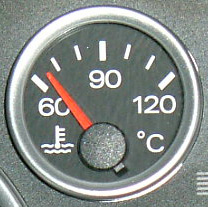Warning Gauges are Usually Center Normal
August 2, 2010 at 5:00 am Chad Upton 2 comments
By Chad Upton | Editor
Even if you don’t know anything about cars, this can help you spot a problem, even if you don’t know what it is.
Virtually every car has a speedometer and a fuel gauge and you can obviously read those gauges. Many cars also have a tachometer; it measures the engine speed in revolutions per minute (rpm). This can help you understand when to shift gears and when you’re burning the least/most fuel.
Some cars have other gauges too. Generally speaking, the needle on most of these other gauges should be near the middle of the gauge when the vehicle is operating normally. Depending on the gauge, it will usually have a red mark on one or both sides of the gauge, indicating trouble if the needle reaches that mark.
Some of these gauges take a few minutes to settle near the center, particularly the various temperature and pressure gauges that may appear in some vehicles.
These are called center normalized gauges and have been a popular gauge design standard for a long time. With so many in-car distractions, simplifying gauge design makes it easy to identify a problem.
In racing some drivers even tape over the sides of the gauges, leaving on the center visible — then they can only see the needle when it is in the center position, making it even easier to identify a problem.
 One of the most popular additional gauges is the engine coolant temperature gauge. It is identified by a symbol that looks like a thermometer partially submerged in liquid. This gauge indicates when your engine is overheating.
One of the most popular additional gauges is the engine coolant temperature gauge. It is identified by a symbol that looks like a thermometer partially submerged in liquid. This gauge indicates when your engine is overheating.
The following gauges are not exactly warning gauges, so they’re exempt from the center normal rule: speedometer (mph or km/h), tachometer (rpm), fuel, and turbo (boost).
Of course, not all cars use center normal gauges, but you’ll be able to tell a few minutes after your car has been running normally.
Broken Secrets
Subscribe on: Facebook | Twitter | Kindle
Sources: Answers.com, umich.edu
Photos: Photo courtesy of Aaron Gold at _cars.about.com_, rastrus (cc)
Entry filed under: Automotive. Tags: auto, automobile, camaro, car, center, gauge, normal, normalized.
2 Comments Add your own
Leave a comment
Trackback this post | Subscribe to the comments via RSS Feed






1. Gaij | August 2, 2010 at 12:24 pm
Gaij | August 2, 2010 at 12:24 pm
A troubling development in auto gauges is the use of “forced centering”. Rather than display the raw sensor output, the signal is processed to make sure it’s in a range of acceptability, and if so, the needle is forced to the center mark. Such gauges are little better than “idiot lights” when it comes to informing the driver about the state of the engine.
2. Gazbo | August 5, 2010 at 1:37 pm
Gazbo | August 5, 2010 at 1:37 pm
Racers and truck drivers like to rotate (round) gauges so that “normal” is at 12:00 on every gauge. ANY problem pops right out and very quickly – especially if you have banks of gauges to monitor as I did in my Peterbilt. It was a real pleasure starting a cold rig and seeing all the dials slowly line up; it took 45 minutes on a cold day.